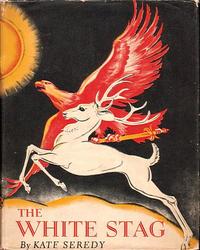Firebird by R. Garcia y Robertson
I picked up Firebird on a whim and because I see Eastern European folklore as unfamiliar and thus a bit outre and I've been reading posts from Joseph Manola's Against the Wicked City. (His campaign setting is an Early Modern weird East setting. I suspect I was also subconsciously influenced because the title reminded me of the cover of a book I read as a child, the White Stag by Kate Seredy. It's been five decades since I read the White Stag and I didn't remember the title or the author, just a vague recollection that the cover and illustrations were beautiful and that the book has something to do with Attila the Hun and/or Hungarian folk tales. If you haven't read Seredy's book it's worth tracking down.
This is the cover I remember from childhood although the one in our library had a big gold seal indicating it was a Newberry Award winner.
But to get back to the Firebird, I liked this book. Really how can you go wrong with a book that is described thusly:
In the fantastic land of Markovy east of Europe, in the Iron Wood filled with werewolves and other unpleasant creatures, in the house of the dreaded Bone Witch, lives a young orphan girl named Aria. Her life is changed forever when a foreign knight, Sir Roye de Roye, enters the forest pursued by enemies, carrying with him the most precious artifact of the kingdom, the egg of the Firebird. Aria saves him and falls in love with him, and it becomes her mission in life to restore the egg to the firebird's nest. And so she and her knight set out on a wonderful quest, filled with spectacle, romance, and hair's-breadth escapes, to save the land and find a life together.
Sir Roye de Roye is an entertaining character and, at least at the start of the book, he is oh so much like a French noble. This is a characterization I found useful to see and keep in mind both for some stereotypes - the French as romantics - as well as for an example of the sort of noble who, even in the early 17th century, hearkens back to the good old days of a Medieval French cultural ethos.
Aria the witch girl is delightful. As a cultural outsider, she wasn't quite raised by wolves, but she isn't far off since she was mostly raised by someone called the Bone Witch - and boy do I love that title. This allows the author to use both Aria and Sir Roye as a convenient method to point out and to comment on elements of the pseudo-Russian society and culture that the reader probably isn't familiar with - or at least I was only somewhat familar with some of the elements.
The setting is a pastiche of not-Europe e.g. Markovy with fictional elements like the Iron Wood that borders Markovy - and the Iron Wood is made of iron that the locals harvest to supply forges and smithies. How much like D&D PCs is that? The setting has many odd and interesting additions like the Iron Wood and Mongol airships. Overall it is a Weird East kind of story.
The story follows elements common to a lot of folk tales so certain things won't come as much of a surprise, but the mix of less familiar Eastern European elements along keeps a bit of mystery.
On the negative side, I found the now de rigueur separation of main characters so they can have their own adventures in alternating chapters before being reunited near the end of the book a bit tedious at times, but it's a style that I feel has been way overused in fiction since about the 1980s. Apparently it doesn't bug other readers or publishers as much as it does me since authors keep selling and publishers keep publishing books written in that style. The plot also gets a little contrived for my taste.
I give it 3.5 out of 4 stars.




No comments:
Post a Comment